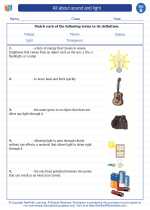All About Sound
Sound is a form of energy that is produced by vibrations. When an object vibrates, it creates sound waves that travel through the air and reach our ears. These waves cause the air particles to vibrate, which our ears then interpret as sound. Sound cannot travel through a vacuum because there are no particles to vibrate and carry the sound waves.
Properties of Sound
- Amplitude: The height of a sound wave, which determines the loudness of the sound.
- Frequency: The number of vibrations per second, which determines the pitch of the sound.
- Wavelength: The distance between two consecutive points in a sound wave, which is related to the pitch of the sound.
How Sound Travels
Sound travels through different mediums, such as air, water, and solids. It travels fastest through solids because the particles are closer together and can transmit the vibrations more efficiently. In general, sound travels faster in denser mediums.
All About Light
Light is a form of electromagnetic radiation that our eyes can detect. It is made up of tiny particles called photons, which travel in waves. Light can travel through a vacuum because it does not need a medium to propagate.
Properties of Light
- Wavelength: The distance between two consecutive peaks of a light wave, which determines the color of the light.
- Speed: The speed of light in a vacuum is approximately 299,792 kilometers per second.
- Reflection: The bouncing back of light when it strikes the surface of an object.
- Refraction: The bending of light as it passes from one medium to another.
How Light Behaves
Light can be absorbed, reflected, or refracted when it interacts with different objects. It can also be separated into its component colors through a process called dispersion, which is what creates rainbows when light passes through water droplets in the atmosphere.
Study Guide
Here are some key points to keep in mind when studying sound and light:
- Understand the basic properties of sound, including amplitude, frequency, and wavelength.
- Learn how sound travels through different mediums and why it travels faster in some mediums than others.
- Explore the properties of light, such as wavelength, speed, reflection, and refraction.
- Understand how light behaves when it interacts with different objects and mediums.
- Examine the ways in which sound and light are similar and different in terms of their propagation and behavior.
By grasping these concepts, you will have a solid understanding of sound and light and their importance in our daily lives.
.◂Science Worksheets and Study Guides Second Grade. All about sound and light
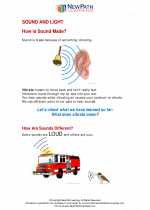
 Worksheet/Answer key
Worksheet/Answer key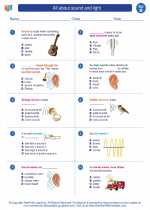
 Worksheet/Answer key
Worksheet/Answer key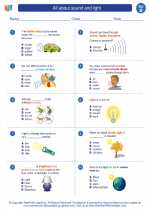
 Worksheet/Answer key
Worksheet/Answer key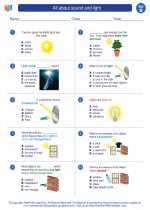
 Vocabulary/Answer key
Vocabulary/Answer key